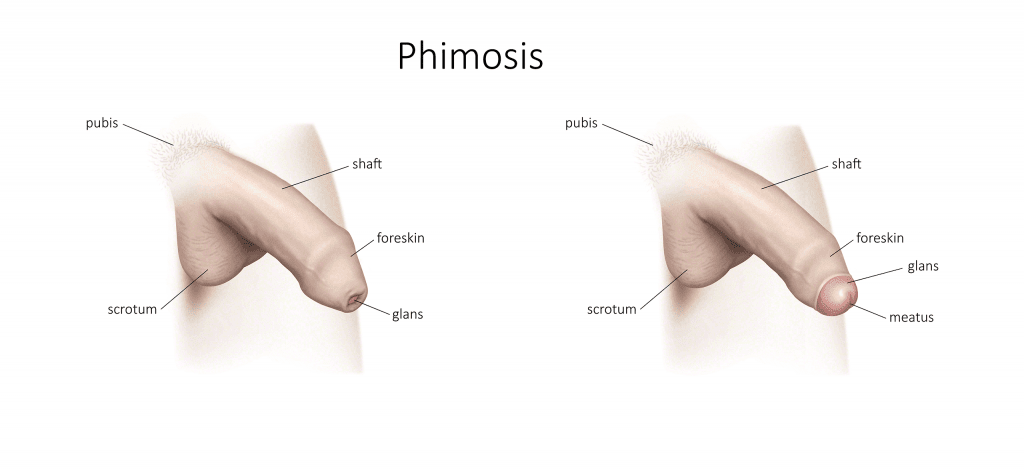What is a phimosis?
A phimosis is a foreskin too tight that no longer retracts for lack of flexibility. Its tightening is variable. It can be light or sometimes very tight which prevents to see the glans completely.


What is the cause of phimosis?
It is sometimes physiological. Some young patients have hypersensitivity of the glans that prevents retraction of the prepuce.
It is most often the result of inflammation or repeated infections of the foreskin (balanitis). Diabetic patients frequently have this problem.
It can also become whitish, thick and hard by a foreskin disease called lichen sclerosus. What are the symptoms of phimosis? Phimosis may be asymptomatic. It prevents however an adequate hygiene. Sometimes, a slight phimosis can crack gradually and it causes erections more and more painful. Phimosis can cause infections (infectious balanitis). Chronic inflammation of phimosis can also cause complications such as adhesion between the glans and prepuce. Penile cancer is rare. It is often the result of poor hygiene.
Moreover, in cases of severe phimosis, urination is sometimes painful. The prepuce can even swell before urine empties.
It is most often the result of inflammation or repeated infections of the foreskin (balanitis). Diabetic patients frequently have this problem.
It can also become whitish, thick and hard by a foreskin disease called lichen sclerosus. What are the symptoms of phimosis? Phimosis may be asymptomatic. It prevents however an adequate hygiene. Sometimes, a slight phimosis can crack gradually and it causes erections more and more painful. Phimosis can cause infections (infectious balanitis). Chronic inflammation of phimosis can also cause complications such as adhesion between the glans and prepuce. Penile cancer is rare. It is often the result of poor hygiene.
Moreover, in cases of severe phimosis, urination is sometimes painful. The prepuce can even swell before urine empties.
Who can have phimosis?
Phimosis can occur at any age. Dr. Marois systematically treats boys, teenagers and men for this problem.
Can we prevent phimosis?
There is no treatment to prevent phimosis in an uncircumcised man. Circumcision in the newborn obviously prevents this complication.
What is the treatment of phimosis?
Creams with corticosteroid base can be proposed but they are generally not very effective in adults. A plasty of the foreskin can be proposed but it is rarely used since the result is mostly rather not very aesthetic. The dilatations of the prepuce are also rarely used and inefficient.
Circumcision is often the most effective and definitive solution. Dr Marois's clinic is a private practice that is equipped with a full urological minor surgical ward. It surpasses the standards established by the Collège des médecins du Québec. Dr Marois is a specialized surgeon urologist who is able to offer you different techniques of circumcision to offer the most appropriate technique according to your anatomy and depending on the complexity of the underlying problem if any.
The esthetic results are then improved compared to standard closure circumcision techniques in separate sutures. Dr Marois is a meticulous surgeon who has a concern for aesthetics. For most men, a more aesthetic circumcision is important.
Circumcision is often the most effective and definitive solution. Dr Marois's clinic is a private practice that is equipped with a full urological minor surgical ward. It surpasses the standards established by the Collège des médecins du Québec. Dr Marois is a specialized surgeon urologist who is able to offer you different techniques of circumcision to offer the most appropriate technique according to your anatomy and depending on the complexity of the underlying problem if any.
The esthetic results are then improved compared to standard closure circumcision techniques in separate sutures. Dr Marois is a meticulous surgeon who has a concern for aesthetics. For most men, a more aesthetic circumcision is important.
See the Circumcision page for the treatment of phimosis:
If there are adhesions between the glans and the foreskin:
- Adherences between the glans and foreskin


